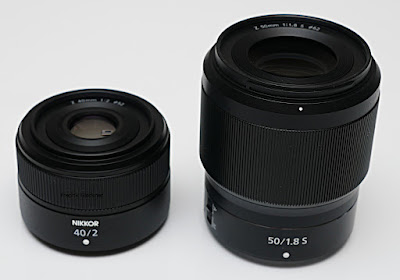Nikon Z 40mm f/2 review
Nikon recently launched the 40mm f/2 lens. This is a basic and compact lens, more reasonably priced than the f/1.8 aperture S-line prime lenses. The newer 40mm lens is seen to the left below, next to the more premium S-line 50mm f/1.8 S (my review):
The 40mm f/2 lens to the left is less prestigious: It has a simpler lens layout, aiming for compactness. The S-line lens on the other hand has larger and more lens elements and has less optical compromises. It also comes at a higher price. Here are some specs compared:
| Lens | Nikon Z 40mm f/2 | Nikon Z 50mm f/1.8 S |
| Number of diaphragm blades | 9 | 9 |
| Lens elements/groups | 6/4 | 12/9 |
| Minimum focus distance | 0.29m | 0.40m |
| Weight | 170g | 415g |
| Diameter | 70mm | 76mm |
| Length | 46mm | 87mm |
| Filter thread | 52mm | 62mm |
Looking at the lens diagram, we clearly see how the compact 40mm lens is much simpler (blue elements are aspherical, yellow are ED glass):
Physical construction
So we have established that the Nikon 40mm f/2 has a simpler, more compact optical construction, how about the rest of the lens? The lens barrel seems to be made from a plastic like material with a fine, matte crinkle finish, which is somewhat grippy. I actually prefer this to the smooth finish of the S line lenses, which is slippery. The 40mm lens seems more ergonomic in this sense.
There is a focus ring which occupies about half of the lens barrel, and it has a rubbery, ribbed material which is easy to operate. It feels nicely dampened.
From the rear, we can see the "elephant in the room", the nylon lens bayonet mount. Some would be disappointed that the lens mount is not steel. However, I think this is a good compromise: It keeps the weight and the price down, and it is more than adequate for such a small and light lens anyway.
Another difference is that the 40mm lens doesn't have any rubber seal around the mount. So it is not as environmentally sealed as the 50mm S-line lens.
The lens doesn't have an AF/Manual switch, to save costs. This is also fine in my opinion. You rarely need this switch with this lens. And if you do, you can operate it from the camera menu.
Mounted on the Nikon Z7, we can appreciate the small size of the lens:
The lens does not come with a hood, and there is no bayonet mount for a hood on the front. I like to have at least a small hood on my lenses, so as an alternative solution, I have been using a 52mm to 49mm step down ring as a miniature hood. Keep in mind that you'll also need a replacement front lens cap as well. Here is how it looks:
This doesn't provide much in terms of sun shade, but it gives some mechanical protection: Avoiding to bump the front glass element into objects by an accident.
Image quality
This is a more basic lens construction, what does it mean for the image quality? To examine it, I have take pictures of the same scenes with both lenses, and moved my tripod a bit back with the 50mm lens for the same approximate field of view.
First a series of images taken at a ininity focus distance
| 40mm f/2 @ f/2 | 50mm f/1.8 S @ f/1.8 |
From these 100% crops from the centre we see that both are pretty much equally good already wide open:
However, 100% crops from the top left corner illustrate how the 40mm lens is not as good as the 50mm S-line lens. Even as I think the 50mm lens has an amazing image quality, it is still not perfect in the extreme corners wide open
And this series was taken at a distance of about 2 feet:
| 40mm f/2 @ f/2 | 50mm f/1.8 S @ f/1.8 |
These 100% crops from the centre show that both lenses are equally good. Centre sharpness is usually not an issue even with simple lenses:
While in the lower right corner, we see that the simpler 40mm lens is indeed not as good:
Bokeh
The nature of the out of focus rendering is quite important with fast lenses. Ideally, it should be smooth and not distracting. In this example series, I have focused on the foreground item at about 0.5m distance, and set the aperture from large to small (click to enlarge images):
| f/2 |
| f/2.8 |
| f/5.6 |
There is a bit of "ringing" around out of focus highlights, but otherwise, the bokeh is quite smooth and efficient. I would say it is quite normal.
The out of focus highlights are also circular across the whole frame, which is nice. Unlike the 50mm f/1.8 S lens, which has "cateye" highlights off the centre of the frame.
Conclusion
I think the Nikon Z 40mm f/2 has a sensible design and construction, and works well as you would expect. The image quality is not perfect, especially in the corners. However, for most conceivable real life uses, this is no problem at all. This is perhaps not the lens to bring for high end landscape photos, but for most other uses it is completely adequate, especially when stopped down a bit.
So who is the lens for? People who are not at all worried about the size, weight and cost, should rather look at the higher end S-line lenses. The Nikon Z 40mm f/2 is good for those who are new to the system and would like to test a prime lens, while not investing a huge amount of money. Or for those who would like to minimize the investment and weight carried. The smaller lens is also less conspicuous when carried in public.
Regarding the focal length, 40mm is a bit unusual. If you are a "glass half empty" person, you could say it is a really dull wide angle lens, or a too short normal lens. On the other hand, 40mm remains a quite nice compromise between the two, for a "do it all" prime lens. It can be used for environmental portraits, and also for groups of people.
I guess the focal length choice also relates to the family of APS-C sensor Nikon Z cameras, where it becomes equivalent to 60mm: A slightly short portrait lens. As the lens performs well in the centre area, it should be a very good companion with APS-C cameras like the or Nikon Z fc.
| Lens | Nikon Z 40mm f/2 | Nikon Z 50mm f/1.8 S |
| Pros | Small, compact, fast, not very expensive. Good ergonomics, nice and grippy barrel and focus ring. Good image quality, nice bokeh. | Very good image quality. High quality construction, and environmentally sealed. |
| Cons | No seal around the lens mount. Image quality is not the best in the corners. | Quite long and heavy. Barrel and even the focus ring are a bit slippery. Cateye bokeh off the centre of the frame at large apertures. |
Further reading
I have made a comparison with the 28mm f/2.8 pancake lens.
Example images
f/2.5, ISO 280, Nikon Z7
f/2, ISO 64, Nikon Z7
f/4, ISO 1250, Nikon Z7
f/2, ISO 180, Nikon Z7






















Comments
Post a Comment